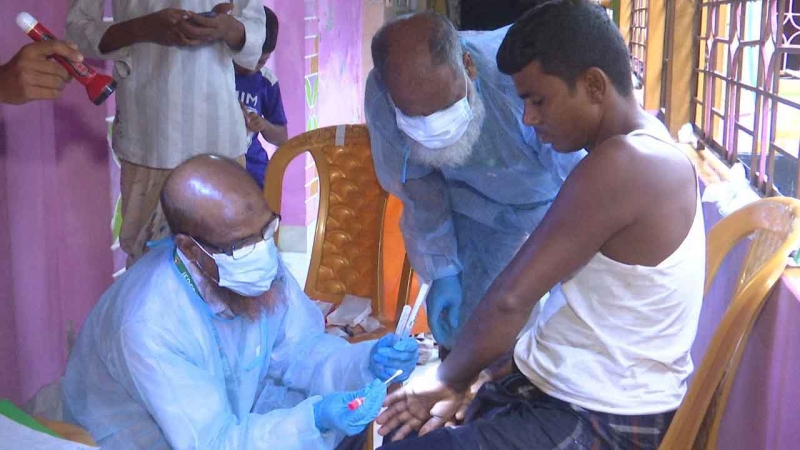- Janaza of six Bangladeshi peacekeepers held at Dhaka Cantonment |
- Bangladesh stock market loses Tk 10,500cr in a week |
- Dhaka’s air turns ‘very unhealthy’ on Sunday morning |
- Project to transform N’ganj into a climate-resilient green city |
- Sustainable, rights-based solutions to Rohingya crisis urged |
Anthrax breaks out in Rangpur, sparks concern in other dists

An anthrax case is being treated in Rangpur. UNB
Rezaul Karim Manik, Rangpur, Oct 2 - An anthrax outbreak that first appeared in Pirgachha upazila of Rangpur has now spread to two more upazilas, with suspected cases reported in Mithapukur and Kaunia, raising alarm among locals.
Health officials said 13 people have so far been diagnosed with anthrax in Pirgachha, where two people died in July and September after developing symptoms of the disease.
The Institute of Epidemiology, Disease Control and Research (IEDCR) sent a special medical team to Pirgachha last month.
On September 13 and 14, they collected samples from 18 suspected patients in Pirgachha Sadar and Parul unions, of which 13 tested positive.
“Samples from frozen beef also tested positive for anthrax spores, while one patient was infected after exposure to contaminated goat meat,” an IEDCR source said.
The Civil Surgeon’s office in Rangpur confirmed that the two earlier deaths were caused by anthrax. At least 100 others in four unions showed symptoms between July and September and livestock officials previously detected the bacteria in diseased cattle slaughtered in the area.
According to Pirgachha Upazila Health Complex, around 60 patients have sought treatment so far, including 30 at the facility’s outpatient department.
Upazila Health Officer Dr Muhammad Tanvir Hasnat said, “We are keeping records of all suspected patients. About 90 percent are recovering with treatment. However, the two deaths we confirmed were directly caused by anthrax.”
Locals in villages such as Deuti, Purba Parul and Anandee Dhaniram reported that over the past two months anthrax killed more than 150 cattle.
The outbreak has also exposed systemic weaknesses in livestock handling and meat sales across Rangpur division. Despite some 1,500 cattle and goats being slaughtered daily in the region’s 1,300 markets, veterinary checks are rarely conducted. No market has a modern slaughterhouse or permanent veterinary presence.
Although laws require livestock to be examined before slaughter and butchers to obtain licenses and health clearance, most traders operate without permits, many claiming ignorance of the rules.
Following the Pirgachha cases, anthrax has spread to neighbouring Sundarganj upazila in Gaibandha district, where 60–65 cattle and goats are slaughtered daily across more than 30 sites. Meat vendor Shukur Ali said checks are carried out only at the municipal market.
“In Ramganj, unhealthy cattle are often slaughtered and the meat supplied wholesale to other areas,” he added.
Livestock Officer Dr Biplob Kumar Dey said authorities were ensuring inspections at Sundarganj’s main slaughterhouses, but admitted enforcement in rural markets remained difficult. A similar situation exists in Taraganj upazila of Rangpur, where more than 60 traders operate without licences and health checks. Local butcher Hasinur Islam admitted he was unaware of the requirement.
“We don’t slaughter sick animals, so we don’t do health tests. Because of limited space, we often slaughter cattle outside,” he said.
Health experts warn that anthrax spreads to humans through contact with infected animals or their products—meat, blood, hides and bones—but not from person to person. The disease typically causes skin lesions and ulcers.
Deputy Civil Surgeon of Rangpur Dr. Ruhul Amin confirmed suspected cases in Mithapukur and Kaunia. “We have sent eight more samples to IEDCR. The results are pending,” he said, urging the public to avoid slaughtering sick cattle.
“We have adequate stocks of antibiotics at upazila health complexes. Treatment is effective if patients come early. But since the disease originates in livestock, prevention depends on veterinary measures.”
Livestock officials said vaccination drives are being intensified. District Livestock Officer Abu Sayeed reported that over 165,000 cattle, goats and sheep have been vaccinated in Pirgachha, Kaunia, Mithapukur and Rangpur Sadar since August 26.
“There is no reason for panic. Awareness programmes are being carried out in mosques, temples and marketplaces,” he said.
Division Livestock Director Dr Abdur Hai Sarkar admitted manpower shortages were a major challenge. “We encourage traders to obtain licences and conduct health checks. But we don’t have enough veterinarians to cover every market. Volunteers are now being engaged to assist with inspections,” he said.
As officials scramble to contain the outbreak, doctors and public health experts warn that continued neglect of veterinary rules could make anthrax a recurring threat in northern Bangladesh. - UNB

